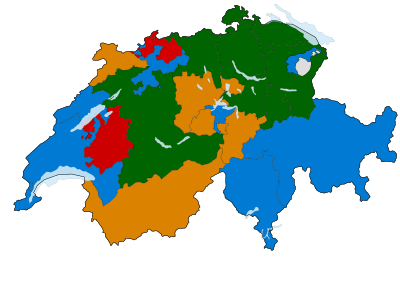Christian Democratic People's Party of Switzerland
The Christian Democratic People's Party of Switzerland (German: Christlichdemokratische Volkspartei der Schweiz, CVP; French: Parti Démocrate-Chrétien, PDC; Italian: Partito Popolare Democratico, PPD; Romansh: ![]()
 | |
| President | Gerhard Pfister |
| Vice Presidents | Ida Glanzmann, Charles Juillard |
| General Secretary | Gianna Luzio |
| Members in Federal Council | Viola Amherd |
| Founded | 1912 |
| Headquarters | Hirschengraben 9 CH-3011 Bern |
| Youth wing | Young CVP |
| Membership (2015) | 100,000[1] |
| Ideology | Christian democracy[2] Moderate social conservatism Support for EU Bilateral Accords |
| Political position | Centre[3][4][5] to centre-right[6][7] |
| European affiliation | European People's Party (associate) |
| Colours | Orange |
| Federal Council | 1 / 7 |
| National Council | 25 / 200 |
| Council of States | 13 / 46 |
| Cantonal executives | 40 / 154 |
| Cantonal legislatures | 435 / 2,609 |
| Website | |
| www | |
The party was founded as the Catholic Conservative Party in 1912. The party peaked in the 1950s, having three members of the Federal Council (1954–58) before agreeing to the Magic formula. It adopted its current name in 1970. From 1979 to 2003, the party's vote declined, mostly in the favour of the Swiss People's Party, and the party was reduced to one Federal Councillor at the 2003 election.
The party sits in the centre to centre-right of the political spectrum, advocating Christian democracy, the social market economy, and moderate social conservatism. The party is strongest in Catholic rural areas, particularly Central Switzerland and Valais.
History
In 1912 the Catholic-Conservative Party of Switzerland (German: Katholisch-Konservative Partei der Schweiz) was founded. From 1919 on, the party occupied two out of the seven seats in the cabinet. Aided by the political climate of the postwar period, the party experienced its peak in the 1950s: It was represented by the biggest parliamentary delegation in the national assembly, and from 1954 to 1958 the party occupied three out of seven seats in the cabinet. Nonetheless, the party had to relinquish the third seat in favor of the 'Magic formula', which was introduced to the cabinet in 1959. In 1957 it changed its name to the Conservative-Christian-Social People's Party (German: Konservativ-Christlichsoziale Volkspartei) and to its current name in 1970. In the ensuing decades, the Catholic voter base dissolved somewhat. The reduction of the voter base, in addition to less cohesion among politicians in the party, led to six successive losses in federal elections after 1980.
Beginning in the 1990s, conservative voters from former strongholds of the CVP switched to vote for the right-wing populist Swiss People's Party. Due to that voter switch and the resultant 2003 national elections to the national assembly, the party lost their second seat in the governing Federal Council, retaining only one of the seven seats.
Party platform
In its party platform, the CVP describes itself as a centrist party. The CVP fosters a social market economy in which a balance is struck between economic liberalism and social justice. The expansion of the party in the Protestant-dominated cantons, in which the CVP upholds rather centrist policies, stands in contrast to the traditional role of the CVP as the leading party in rather Catholic-dominated cantons of central Switzerland, and the cantons of Valais. There, the electorate is mostly socially conservative.
The CVP has three main policies in the political centre:
- The CVP upholds the social market economy. It supports exporting industries, more spending on education, research and development. It also aims at combating the black market and tax evasion. In order to increase efficiency and incentives, the CVP calls for the reduction and streamlining of bureaucratic procedures and government agencies, low taxation for family enterprises and those who offer vocational education and internships. The CVP calls for equal wages and job opportunities for both men and women.
- The CVP calls for flexible working times, childcare, and affordable housing.
- The CVP aims at ensuring social security. The CVP calls for reforms of the social security system, by raising taxes on demerit goods (e.g. tobacco taxes) to generate more revenues for the pension funds. The retirement age of 65 should also be upheld. The public health care system shall be streamlined by a reduction of waiting times of medical procedures, in order to ensure equitable services. The CVP also promotes workfare as the primary means to combat unemployment.
Popular support



Following continuing losses in the federal parliamentary elections until 2003, in December 2003, the party lost one of its two seats in the four-party coalition government, the Swiss Federal Council, to the Swiss People's Party. The CVP holds roughly 12% of the popular vote.
After the national election in late 2003, it held 28 seats (out of 200) in the Swiss National Council (first chamber of the Swiss parliament); 15 (out of 46) in the Council of States (second chamber, and the largest party in this chamber) and 1 out of 7 seats in the Swiss Federal Council (executive body).
In 2005, it held 20.7% of the seats in the Swiss Cantonal governments and 16.7% in the Swiss Cantonal parliaments (index "BADAC", weighted with the population and number of seats). At the last legislative national elections, 22 October 2007, the party won 14.6% of the popular vote and 31 out of 200 seats in the National Council lower house.[10] This was a gain of 3 seats, ending the long-term decline of the party and it was the only one of the four largest parties besides the Swiss People's Party to gain votes and seats.
In the Federal Assembly, the CVP formerly sat in a bloc in the Christian Democrats/EPP/glp Group, along with the Evangelical People's Party and Green Liberal Party.[11]
Election results
| Year | Votes | % | Seats | +/- |
|---|---|---|---|---|
| 1914 | 71,668 | 21.1 | 37 / 189 |
|
| 1917 | 84,784 | 16.4 | 42 / 189 |
|
| 1919 | 156,702 | 21.0 | 41 / 189 |
|
| 1922 | 153,836 | 20.9 | 44 / 198 |
|
| 1925 | 155,467 | 20.9 | 42 / 198 |
|
| 1928 | 172,516 | 21.4 | 46 / 198 |
|
| 1931 | 184,602 | 21.4 | 44 / 187 |
|
| 1935 | 185,052 | 20.3 | 42 / 187 |
|
| 1939 | 105,018 | 17.0 | 43 / 187 |
|
| 1943 | 182,916 | 20.8 | 43 / 194 |
|
| 1947 | 203,202 | 21.2 | 44 / 194 |
|
| 1951 | 216,616 | 22.5 | 48 / 196 |
|
| 1955 | 226,122 | 23.2 | 47 / 196 |
|
| 1959 | 229,088 | 23.3 | 47 / 196 |
|
| 1963 | 225,160 | 23.4 | 48 / 200 |
|
| 1967 | 219,184 | 22.1 | 45 / 200 |
|
| 1971 | 407,225 | 20.4 | 44 / 200 |
|
| 1975 | 407,286 | 21.1 | 46 / 200 |
|
| 1979 | 390,281 | 21.3 | 44 / 200 |
|
| 1983 | 396,281 | 20.2 | 42 / 200 |
|
| 1987 | 378,822 | 19.6 | 42 / 200 |
|
| 1991 | 367,928 | 18.0 | 35 / 200 |
|
| 1995 | 319,972 | 16.8 | 34 / 200 |
|
| 1999 | 309,118 | 15.8 | 35 / 200 |
|
| 2003 | 301,652 | 14.4 | 28 / 200 |
|
| 2007 | 335,623 | 14.5 | 31 / 200 |
|
| 2011 | 300,544 | 12.3 | 28 / 200 |
|
| 2015 | 293,653 | 11.6 | 27 / 200 |
|
| 2019 | 275,842 | 11.4 | 25 / 200 |
Party strength over time
| Canton | 1971 | 1975 | 1979 | 1983 | 1987 | 1991 | 1995 | 1999 | 2003 | 2007 | 2011 | 2015 |
|---|---|---|---|---|---|---|---|---|---|---|---|---|
| Switzerland | 20.3 | 21.1 | 21.3 | 20.2 | 19.6 | 18.0 | 16.8 | 15.9 | 14.4 | 14.5 | 12.3 | 11.6 |
| Zürich | 9.5 | 9.4 | 9.7 | 9.1 | 7.1 | 5.9 | 4.9 | 5.1 | 5.4 | 7.6 | 5.0 | 4.2 |
| Bern | 5.3 | 5.3 | 2.5 | 2.1 | 2.4 | 2.6 | 1.8 | 2.4 | 2.3 | 4.7 | 2.1 | 1.8 |
| Luzern | 48.8 | 50.1 | 50.4 | 49.6 | 47.0 | 48.6 | 37.3 | 33.8 | 29.5 | 30.2 | 27.1 | 23.9 |
| Uri | *a | 18.6 | * | * | * | * | * | * | * | * | * | 26.8 |
| Schwyz | 38.5 | 46.4 | 49.4 | 46.6 | 36.9 | 32.8 | 27.4 | 27.3 | 23.4 | 20.1 | 20.6 | 19.5 |
| Obwalden | 67.0 | 97.1 | 95.7 | 91.0 | 51.7 | 95.3 | 94.2 | * | 66.4 | 32.5 | * | * |
| Nidwalden | 97.2 | 97.6 | 49.5 | 97.2 | 96.9 | 97.7 | 32.1 | * | * | * | * | * |
| Glarus | * | * | * | * | * | * | * | * | * | * | * | * |
| Zug | * | 39.4 | 34.1 | 39.9 | 34.2 | 34.2 | 27.1 | 26.4 | 22.9 | 23.3 | 24.3 | 26.4 |
| Fribourg | 41.5 | 46.9 | 39.9 | 37.9 | 37.7 | 36.8 | 36.0 | 33.7 | 25.4 | 24.8 | 20.3 | 22.7 |
| Solothurn | 27.7 | 26.0 | 27.6 | 26.7 | 25.1 | 22.2 | 21.5 | 21.4 | 21.0 | 20.4 | 17.9 | 14.8 |
| Basel-Stadt | 11.2 | 12.1 | 13.9 | 9.9 | 10.0 | 10.4 | 9.7 | 8.6 | 6.6 | 7.4 | 6.5 | 6.4 |
| Basel-Landschaft | 13.3 | 13.3 | 11.5 | 10.8 | 12.3 | 11.6 | 11.7 | 12.0 | 10.0 | 11.4 | 8.2 | 9.1 |
| Schaffhausen | 8.0 | * | * | 6.3 | * | * | * | * | 2.7 | * | 5.2 | * |
| Appenzell A.Rh. | * | 14.1 | * | 14.5 | * | 16.7 | 9.5 | * | * | * | 10.6 | * |
| Appenzell I.Rh. | 96.1 | 98.3 | 97.2 | 95.6 | 91.8 | 98.7 | 85.4 | 73.5 | 69.2 | 84.6 | 76.1 | 76.3 |
| St. Gallen | 44.0 | 43.3 | 44.1 | 40.8 | 39.4 | 35.8 | 31.0 | 26.2 | 22.2 | 21.4 | 20.3 | 16.6 |
| Graubünden | 37.3 | 35.9 | 35.5 | 33.3 | 28.5 | 25.6 | 26.9 | 25.6 | 23.7 | 20.3 | 16.6 | 16.8 |
| Aargau | 20.0 | 20.6 | 22.5 | 21.5 | 18.9 | 14.5 | 14.2 | 16.3 | 15.6 | 13.5 | 10.6 | 8.6 |
| Thurgau | 23.4 | 22.3 | 24.6 | 21.6 | 20.4 | 16.5 | 13.0 | 15.7 | 16.5 | 15.2 | 14.4 | 13.1 |
| Ticino | 34.8 | 35.7 | 34.1 | 34.0 | 38.2 | 26.9 | 28.4 | 25.9 | 24.6 | 24.1 | 20.0 | 20.1 |
| Vaud | 5.3 | 4.6 | 5.1 | 4.5 | 4.1 | 3.6 | 5.6 | 4.5 | 4.4 | 5.6 | 4.6 | 4.1 |
| Valais | 61.5 | 59.7 | 58.8 | 57.5 | 58.7 | 54.3 | 54.8 | 51.4 | 47.9 | 44.9 | 39.9 | 39.8 |
| Neuchâtel | * | * | * | * | * | * | * | * | * | 3.3 | 3.5 | 3.6 |
| Genève | 13.8 | 14.7 | 14.0 | 12.3 | 14.6 | 14.5 | 13.4 | 14.1 | 11.8 | 9.7 | 9.8 | 12.1 |
| Jura | b | b | 37.7 | 25.1 | 33.0 | 36.0 | 38.2 | 39.2 | 39.5 | 25.0 | 33.2 | 27.6 |
Presidents
- 1986–1992 Eva Segmüller, St. Gallen
- 1992–1994 Carlo Schmid-Sutter, Appenzell Innerrhoden
- 1994–1997 Anton Cottier, Fribourg
- 1997–2001 Adalbert Durrer, Obwalden
- 2001–2004 Philipp Stähelin, Thurgau
- 2004–2006 Doris Leuthard, Aargau
- 2006-2016 Christophe Darbellay, Valais
- 2016–present Gerhard Pfister, Zug
Secretary Generals
- 1988–1992 Iwan Rickenbacher
- 1992–1997 Raymond Loretan
- 1997–2001 Hilmar Gernet
- 2001–2008 Reto Nause
- 2009–2012 Tim Frey
- 2012–2018 Béatrice Wertli
- 2018–present Gianna Luzio
Notes and references
- The Swiss Confederation – A Brief Guide. Federal Chancellery. 2015. p. 19. Archived from the original on 20 December 2016. Retrieved 14 December 2016.
- Nordsieck, Wolfram (2019). "Switzerland". Parties and Elections in Europe. Retrieved 9 November 2019.
- Altermatt, Urs (2013). CVP: Von der katholischen Milieupartei zur Partei der bürgerlichen Mitte. Die Parteien in Bewegung: Nachbarschaft und Konflikte. Verlag Neue Zürcher Zeitung. pp. 36–37.
- Burlacu, Diana; Tóka, Gábor (2014). Policy-based Voting and the Type of Democracy. Elections and Democracy: Representation and Accountability. Oxford University Press.
- Budge, Ian; Keman, Hans; McDonald, Michael D.; Pennings, Paul (2012). Organizing Democratic Choice: Party Representation Over Time. Oxford University Press. p. 134.
- Damir Skenderovic (2009). The Radical Right in Switzerland: Continuity and Change, 1945-2000. Berghahn Books. p. 156. ISBN 978-1-84545-948-2. Retrieved 19 July 2013.
- Freedom House (1 December 2011). Freedom in the World 2011: The Annual Survey of Political Rights and Civil Liberties. Rowman & Littlefield Publishers. p. 649. ISBN 978-1-4422-0996-1.
- Philip Manow; Kees van Kersbergen (2009). Religion and the Western Welfare State—The Theoretical Context. Religion, Class Coalitions, and Welfare States. Cambridge University Press. p. 21. ISBN 978-0-521-89791-4. Retrieved 2 August 2013.
- The data is based on research by Philipp Leimgruber (University of Bern), Dominik Hangartner (Washington University) and Lucas Leemann (Columbia University), as part of the University of Lausanne's Swiss Electoral Studies (Selects), http://www2.unil.ch/selects%5B%5D, as published in Comparing Candidates and Citizens in the Ideological Space, Swiss Political Science Review 16(3) pp. 499-531(33). The graphical representation of the data is based on a graphic published in the Neue Zürcher Zeitung of 30 October 2010, p.13.
- Nationalrat 2007
- Archived 3 November 2009 at the Wayback Machine
- Nationalratswahlen 2015: Der Wandel der Parteienlandschaft seit 1971 (Report). Swiss Federal Statistical Office. 2015. Archived from the original on 2 August 2016. Retrieved 19 July 2016.
| Part of a series on |
| Christian democracy |
|---|
 |
|
Ideas
|
|
Further reading
- Gees, Thomas (2004). Michael Gehler; Wolfram Kaiser (eds.). Successful as a 'Go Between': The Conservative People's Party in Switzerland. Christian Democracy in Europe since 1945. Routledge. pp. 33–46. ISBN 0-7146-5662-3.
- Rölli-Alkemper, Lukas (2004). Wolfram Kaiser; Helmut Wohnout (eds.). Catholics between Emancipation and Integration: The Conservative People's Party in Switzerland. Political Catholicism in Europe 1918-45. Routledge. pp. 53–64. ISBN 0-7146-5650-X.